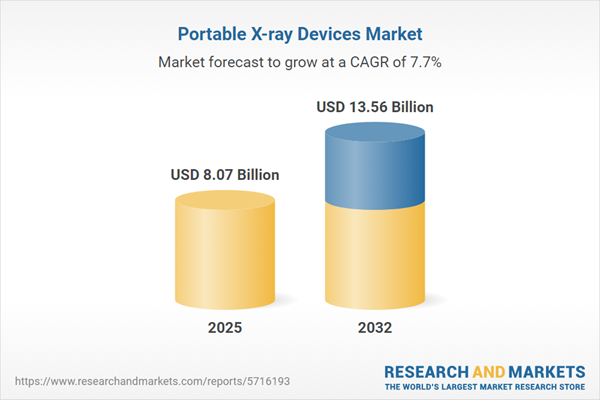Speak directly to the analyst to clarify any post sales queries you may have.
Portable X-ray devices are redefining fast-response diagnostics and secure screening processes across healthcare and security sectors. Rapidly deployed and versatile, these systems address critical unmet needs where traditional imaging infrastructure is unavailable or impractical, marking a shift in global medical and safety practices.
Market Snapshot: Portable X-ray Device Market Growth
The Portable X-ray Devices Market grew from USD 7.50 billion in 2024 to USD 8.07 billion in 2025. It is expected to continue growing at a CAGR of 7.68%, reaching USD 13.56 billion by 2032.
This momentum is underpinned by an expanding global population, technological leaps, and new operational demands within both healthcare and security domains.Scope & Segmentation of the Portable X-ray Device Market
This comprehensive report examines the entire spectrum of the portable X-ray device market, with detailed segmentation to help guide strategic planning and market entry approaches:
- Technology: Analog Radiography, Computed Radiography, Digital Radiography
- Application: Dental Imaging (Intraoral Imaging, Panoramic Imaging); Medical Imaging (Chest Imaging, Extremities Imaging, Spine Imaging); Security Inspection (Baggage Screening, Border Security, Cargo Inspection)
- Portability: Cart Based, Handheld
- Power Source: Battery Operated, Corded Electric
- Regions: Americas (United States, Canada, Mexico, Brazil, Argentina, Chile, Colombia, Peru), Europe, Middle East & Africa (United Kingdom, Germany, France, Russia, Italy, Spain, Netherlands, Sweden, Poland, Switzerland, United Arab Emirates, Saudi Arabia, Qatar, Turkey, Israel, South Africa, Nigeria, Egypt, Kenya), Asia-Pacific (China, India, Japan, Australia, South Korea, Indonesia, Thailand, Malaysia, Singapore, Taiwan)
- Companies: Siemens Healthineers AG, General Electric Company, Koninklijke Philips N.V., Canon Medical Systems Corporation, Fujifilm Holdings Corporation, Shimadzu Corporation, Hitachi, Ltd., Carestream Health, Inc., MinXray, LLC, Source-Ray, Inc.
Key Takeaways for Senior Decision-Makers
- Portable X-ray systems are vital in settings where fixed diagnostic equipment is either inaccessible or too slow to deploy, such as remote clinics and emergency locations.
- Digital connectivity and miniaturization trends enhance device usability and the speed of diagnostic decision-making, further supporting telemedicine and remote consultation models.
- AI-driven diagnostic tools are being integrated, offering automated anomaly detection and supporting clinicians in case triage, especially in high-throughput hospital and screening settings.
- Security agencies benefit from improved imaging clarity and sensitivity, reducing false positives in baggage and cargo inspections, which streamlines operations at critical infrastructure points.
- Cart-based and handheld models serve distinct operational requirements, making procurement decisions highly dependent on mobility needs, available power sources, and workflow ergonomics.
- Regional market dynamics are shaped by local infrastructure maturity, regulatory standards, and specific healthcare and security priorities, necessitating tailored strategies for effective penetration.
Impact of United States Tariff Measures on the Portable X-ray Device Market
Forthcoming United States tariff measures in 2025 are set to alter production and sourcing strategies, particularly regarding electronics and detector materials. Original equipment manufacturers are diversifying supply chains and reassessing procurement, while innovations in component design aim to offset increased production costs. Alternative pricing models, such as leasing and service contracts, are emerging to sustain demand among cost-sensitive buyers despite tariff-driven price shifts.
Methodology & Data Sources
The report synthesizes data from a broad array of public filings, industry interviews, and technical publications. Key opinions were collected from sector experts, and findings were validated through triangulation with supplier disclosures and government documentation. This rigorous approach ensures reliability and actionable insight for stakeholders.
Why This Report Matters
- Delivers evidence-based guidance for capital allocation in rapidly evolving diagnostic and security-related imaging markets.
- Provides strategic clarity for navigating regional regulations, tariff impacts, and shifting technology standards.
- Equips decision-makers with objective analysis on segmentation patterns, application trends, and competitive dynamics.
Conclusion
As portable X-ray devices gain traction across segments and geographies, continued innovation and adaptability remain critical. Industry leaders who align strategies with market realities and evolving customer requirements can effectively capture emerging opportunities.
Additional Product Information:
- Purchase of this report includes 1 year online access with quarterly updates.
- This report can be updated on request. Please contact our Customer Experience team using the Ask a Question widget on our website.
Table of Contents
3. Executive Summary
4. Market Overview
7. Cumulative Impact of Artificial Intelligence 2025
List of Figures
Companies Mentioned
The companies profiled in this Portable X-ray Devices market report include:- Siemens Healthineers AG
- General Electric Company
- Koninklijke Philips N.V.
- Canon Medical Systems Corporation
- Fujifilm Holdings Corporation
- Shimadzu Corporation
- Hitachi, Ltd.
- Carestream Health, Inc.
- MinXray, LLC
- Source-Ray, Inc.
Table Information
| Report Attribute | Details |
|---|---|
| No. of Pages | 186 |
| Published | October 2025 |
| Forecast Period | 2025 - 2032 |
| Estimated Market Value ( USD | $ 8.07 Billion |
| Forecasted Market Value ( USD | $ 13.56 Billion |
| Compound Annual Growth Rate | 7.6% |
| Regions Covered | Global |
| No. of Companies Mentioned | 11 |









